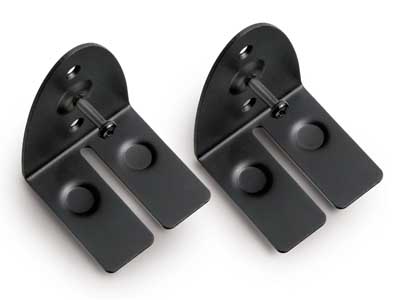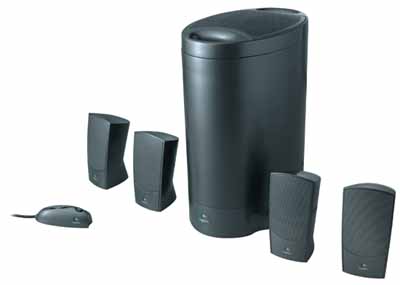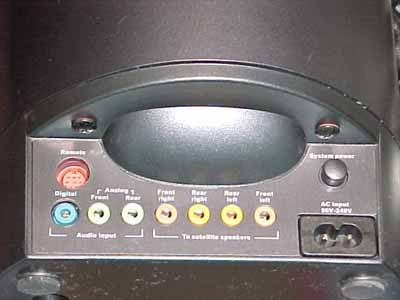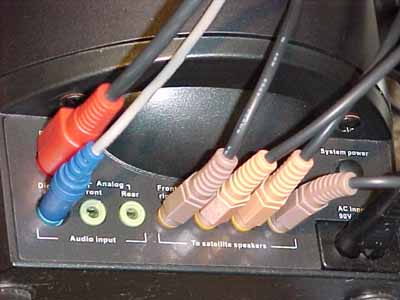
Original Link: https://www.anandtech.com/show/719
Logitech SoundMan Xtrusio DSR-100
by Jim Warren on February 14, 2001 1:02 AM EST- Posted in
- Smartphones
- Mobile
Introduction
Early last May Logitech offered a preview of their new speaker models within the SoundMan product line. The three lower end models, the SR-30, S-20, and S-4 have been available for quite a while, though the flagship of the line, the Xtrusio DSR-100 is just now hitting the market. It is by far the highest powered system in their line, offering a total output of 100 watts RMS.
Though Logitech may be more known for their pointing devices and other interface devices, computer audio systems are an extension of their efforts to integrate the analog world we live in to the digital world of computers. Their efforts have resulted in some excellent devices and they have made a strong effort to carry these same intentions over to their multimedia line.
The DSR-100 system is a 4.1 speaker system, consisting of independent left and right front and rear surround speakers coupled with a subwoofer designed to extend the low end frequency response of the entire package. While Logitech employed the traditional plastic enclosures for the satellite speakers, they have used an extruded aluminum enclosure for the subwoofer, which also houses the amplifier and power supply. This definitely adds mass to the subwoofer enclosure and allows for the driver to get down to work moving air instead of flexing a plastic enclosure.

In addition to the four satellites and the subwoofer enclosure, the system includes a wired remote control that has functions for the power switch, volume and front to rear fader controls, in addition to housing an 1/8” headphone jack. The system also includes a copy of CyberLink’s PowerDVD software for DVD playback. Here’s what Logitech says about their system:
|
Specifications
(Courtesy of Logitech)
|
|
|
RMS Power: |
Total
100W @ 10%THD |
|
Frequency response: |
28Hz - 20kHz |
|
Crossover frequency |
160 Hz |
|
S/N Ratio: |
80dB |
|
Input sensitivity: |
130 mV max. |
|
Input impedance |
10 kW |
|
Signal input (audio source) |
Two 3.5 mm (1/8”) analog stereo jacks One 3.5 mm (1/8”) digital 4-channel jack |
|
Signal output (headphones) |
3.5 mm (1/8”) stereo mini-connector |
|
Power Supply: |
AC 90V-240V (built-in auto-switching transformer) |
|
Satellite Driver (per satellite) |
57 mm diameter neodymium magnet driver, shielded |
|
Subwoofer driver |
150 mm diameter driver, magnetically shielded |
|
Satellite dimensions (HxWxD) |
6x3x3 in (152x76x76 mm) each |
|
Subwoofer dimensions (HxWxD) |
12.2x7.5x11 in (310x190x280 mm) |
|
System weight |
14.75 lb (6.7 kg) |
Setup
The DSR-100 is a fairly straightforward package that assembles quickly. An effort was made to keep assembly simple with such features as color coded connections and integrated wiring. Overall, this reduces the number of parts coming out of the box, though it could make trouble shooting any bad parts more difficult.
First out of the box are the four satellite speakers. Both the front and rear satellites are identical except that the front speakers are prewired with shorter speaker cables. The jacks are also color coded for front and rear, corresponding to the different lengths. It is up to the user to ensure that the left and right channels are not swapped, as there is no differentiation on the connectors.
The next items out of the box are the wired remote and cables for both analog and digital connections, in addition to two wall mount stands for the rear satellites. Finally, the subwoofer and power cable can be laid out, though as always the power connection should be connected only once all other connections have been made. Placing the subwoofer near where it will be located prior to running the speaker wires makes the layout the easiest as it is the destination for all of the cables.
For placing the speakers, the front satellites should be spaced evenly around a center line to the user. For individual computer users or gamers, this is most often placing them to each side of the monitor. The main idea is to create an isosceles triangle (equal distance from each speaker to the ears) with the user at the apex. The rear surrounds should be placed at ear level with the same technique behind the user. Though the system does not include floor stands for use in larger rooms, the wall stands should suit users in smaller rooms. The longer speaker cords are 150”; this allows some flexibility in placement.

There are two different options for making the audio connections in the system. For those users whose sound card offers a multichannel digital audio connection such as the SoundBlaster Live!, it is essentially one connection that has four conductors for two separate stereo audio channels (front and rear). There are also two adaptors included that will adapt to a multipin connection or RCA coax connection. This system makes for an extremely easy connection to the audio card while still maintaining a high quality digital connection. Also provided are two stereo cables for analog connections to stereo front and rear outputs on a four channel soundcard that does not offer the digital output. When both the analog connections and the digital connections are connected, the speaker system will default to the digital connection.
The last thing to connect prior to the main power is the wired remote. It connects to the subwoofer unit via a multi pin connector and prewired cable. The remote contains the standby button (the main power switch is on the subwoofer), a front to rear fader control, volume fader, and headphone jack. It has a rather small profile that will not take up desk space, though could get lost in the clutter. When headphones are connected, the main speakers are muted. For those without a front panel headphone connection the convenience of having a desktop connection is valuable.

Finally, the main power is connected. The power supply is universal; it will automatically switch to voltages between 90V and 240V AC. The power supply is internal so there is no bulky wall wart to take up space on the wall or power strip; both the amplifiers and power supply are integrated into the subwoofer enclosure. Once all of the connections are made, the main power switch on the sub can be engaged, and then the sub can be finally placed. Moving it towards a wall or beneath a desk can increase the boominess of the sub by helping to reflect more of the bass towards the listener.
The final step in configuring the system is tuning it to the individual preferences of the listener. On the side of the sub are two tonal controls allowing for changes in the sound at the 100 Hz and the 10 kHz levels. Once these are initially adjusted for personal preference, the sub can be tucked away as volume and power are controlled by the remote.

The Sound
The first music these speakers reproduced indicated that they had some strong potential. As these first sonic impressions were actually in the final stages of the setup during the tuning stage, this was a strong start for the system. Initially the system showed moderate strength in the lower midrange frequencies that can sometimes be lacking in a satellites/subwoofer system. However, with a few adjustments to the 100 Hz and 10 kHz knobs, the system quickly zeroed in on a fairly level frequency response. These frequencies were well chosen as adjustment points for the system by working to balance the natural response of the drivers through equalization.
Overall, the system is very musical; it also has the power to bring it up to a high intensity gaming system as well. For music listening, it maintains strength into the lower midrange frequencies, effectively bridging the gap between the subwoofer and satellite responses. This indicates that the driver choice was well matched with the crossover point. The end result is that there is little to no dip in the low midrange frequencies that causes other system to sound somewhat hollow at lower levels. For listening to CDs or MP3s, the system will accurately reproduce the spectrum.
When changing gears into gaming mode, the power in the system keeps up to most demands. The sub and satellites are fairly powerful for the level of system. A little Unreal Tournament revealed that the system ramps up well to higher SPL levels. The first distortion was evident in the upper midrange frequencies in the satellites, and some muddiness in the subwoofer became evident in the subwoofer as things got more intense. However, at that point, the volume was high enough to need to sit back and the sub was flapping against our pant legs. So as a 4.1 gaming system, it definitely keeps up.
Noise in the system is at a fairly typical level for computer speakers. The noise level is low enough that it is possible to hear the noise off of the sound card as changes in the software mixer are made. What this means is that the speaker system is adding a relatively low level of extra noise when compared to what’s coming off the soundcard, so it is a relatively quietly system.
The sound quality from the system overall is very strong. For listening to DVDs using the included PowerDVD software set to 4 channel output, an effective surround sound environment is created. By creating a sonically strong system, it can serve multiple purposes that need quality reproduction by extending beyond high intensity gaming to both music and games.
Conclusion
Standing at the top of Logitech’s SoundMan speaker line, the DSR-100 is a high powered 4.1 speaker system that brings another quality option to the market. It combines higher power with moderate features to be a straightforward system that focuses on the sound and not on the gimmicks.
The setup process for the system was fairly straightforward. The choice of digital or analog connection adds flexibility to the system. For those users whose 4 channel audio card offers the digital output, it makes for an excellent sounding and easy setup. The cable lengths are for a moderate size setup, definitely designed for the desktop and not the living room. The system went up quickly and got down to business.
The remote control simplifies the user interface to the system by allowing all of the components to be placed during installation and then left alone. It has the power and volume controls, in addition to front to rear fader and a headphone connection. Moving the headphone connection to the desktop is a quality feature for users who do not have easy access to their headphone jack. If anything, it is a little small and could get pushed around a cluttered desktop, though it could be secured to a surface should the user choose to arrange their own mounting system.
The physical design of these speakers is worth a little bit of mention as the enclosure design influences the sound some. Instead of squat cubes, the satellites are taller with a slight angle designed to project the sound up to a listener’s ears. The extra height allows the source of the sound to be above desk clutter; there’s less to interfere with the listening experience this way. The subwoofer is also designed in the taller, skinnier style; if it’s under the desk, there’s definitely more foot room.
The sound of the system is very strong. It seems to have overcome some of the tonal problems that plague satellite/sub combinations to keep a level frequency response. This allows it to serve as a music or DVD playback system when it’s not serving its primary role as a gaming system. The functionality helps reinforce the value of the system.

The Logitech Xtrusio DSR-100 system is an excellent option for a 4.1 speaker system. It provides a combination of both sonic quality with power that will satisfy many users. It is primarily suited to gamers looking for 4.1 compatiblity for use with games offering four channel output, though will extend to other applications with ease. At $179, the system represents an investment in quality, though the value is still strong. To sweeten the deal, a full retail version of PowerDVD that otherwise would be $49 is included in the package. The system will not disappoint.










